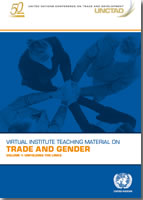
This teaching material explores the consequences of trade for women’s economic empowerment and well-being and the impact of gender inequality on trade.
Since the economy is a gendered structure, any impact of trade on the economy is likely to have gender-specific repercussions.
Looking at countries’ socio-economic structure through a gender lens is therefore the general framework, which is described in Section 2.
Sections 3 and 4 then discuss some key concepts and issues in this area, paving the way for analysis in the following sections. Specifically, Section 3 presents a set of key indicators for measuring gender inequality and provide the reader with the necessary tools to understand which indicator is more appropriate to use depending on the purpose of his/her study.
Section 4 explores different definitions of trade used in research and policymaking, as well as provide some clarifications on how we use the term “trade” in this teaching material. After tackling these introductory definitions, the analysis turns to the core issues at stake in the trade and gender debate.
Section 5 presents the multiple channels of interaction between trade and gender.
Section 6 then looks at the country case study of Angola, with the objective of applying the previously presented theory to some hard data, as well as providing an initial insight and empirical evidence on the trade and gender debate.
The final section (Section 7) introduces the notion of “mainstreaming gender into trade policy”: its meaning in practice, challenges encountered and the steps that need to be taken for trade policy to fully acknowledge and address gender-based inequalities.
The module concludes with exercises and questions for discussion.
At the end of this module, students should be able to:
- Identify topics related to the trade and gender relationship and understand why and when it is important to investigate them.
- Explain why the economy is a gendered structure and describe its main constitutive elements.
- Compare the strengths and weaknesses of different indicators of gender inequality and identify relevant data sources.
- Understand the difference between “trade” and “trade policy” as well as define and compare different measures of trade.
- Describe the main channels through which gender and trade interact while understanding that the trade and gender relationship is a bi-directional one.
- Understand and gain confidence with the use of a range of different gender analysis frameworks.
- Define the concept of “mainstreaming gender into trade policy”.




